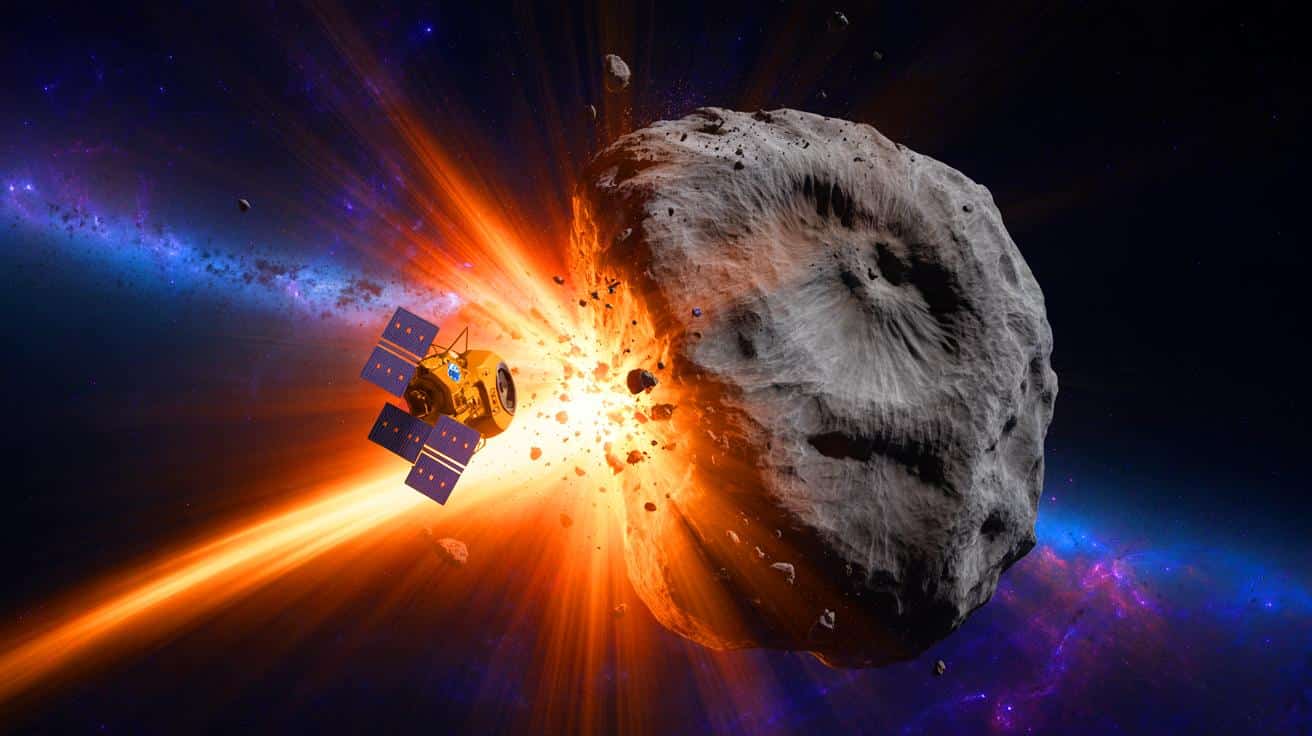IN A NUTSHELL
🚀 NASA’s DART mission successfully altered the trajectory of the asteroid Dimorphos.
🪐 The impact unexpectedly changed the shape of Dimorphos from oblate to prolate.
🔄 Post-impact analysis reveals irregular rotation and potential chaotic movement of Dimorphos.
The mission provides valuable insights for future planetary defense strategies.
In September 2022, NASA’s DART mission achieved a groundbreaking milestone by demonstrating that a deliberate impact could alter an asteroid’s trajectory. The primary objective was to test a planetary defense method by changing the orbit of Dimorphos, a satellite of the asteroid Didymos. However, new analyses suggest that the mission’s effects extended far beyond its initial goals. Not only was the trajectory successfully altered, but the very shape and rotation of Dimorphos experienced significant changes. This unexpected outcome has sparked interest in the scientific community, offering new insights into asteroid dynamics and the potential for planetary defense strategies.
A Milestone in Planetary Defense
The 26th of September 2022 marked a historic achievement for space exploration with NASA’s DART mission. The mission aimed to slightly alter the trajectory of Dimorphos, a satellite orbiting the larger asteroid Didymos. This controlled collision was part of a test to evaluate the efficacy of a planetary defense strategy. Upon initial analysis, the mission was deemed a success as it confirmed the desired change in the asteroid’s orbit. However, the mission’s impact went beyond merely shifting the trajectory. Detailed analyses revealed that the collision had also transformed Dimorphos’ shape.
Initially, Dimorphos had an “oblate” shape, flattened at the poles, reminiscent of a hamburger. The post-impact observations revealed a transformation into a “prolate” shape, elongated along its axis, similar to a rugby ball. This alteration is attributed to the redistribution of internal materials and the ejection of debris. These findings were supported by images captured immediately after the collision, showcasing the dramatic change in morphology.
Unexpected Changes in Orbital Behavior
Beyond altering its shape, the DART mission has also disrupted Dimorphos’ orbital behavior. Under the leadership of Derek Richardson from the University of Maryland, the research team discovered significant changes in how Dimorphos interacts with its primary asteroid, Didymos. Prior to the DART mission, Dimorphos exhibited synchronous rotation, always showing the same face towards Didymos, much like the Moon does with Earth.
However, post-impact analyses indicate that this synchronous rotation has been disrupted. Dimorphos now appears to be entering an irregular rotation, which could potentially evolve into chaotic movement. Such a transformation has profound implications for understanding the dynamics of celestial bodies and raises questions about the long-term effects of human interventions in space.
Implications for Future Asteroid Deflection
The unexpected outcomes of the DART mission provide valuable lessons for future asteroid deflection efforts. While the primary goal of altering an asteroid’s trajectory was achieved, the secondary effects on shape and rotation highlight the complexity of such missions. The findings suggest that any future attempts at asteroid deflection will need to consider the potential for unforeseen consequences.
Moreover, these results underscore the importance of continuous monitoring and analysis following any deflection attempt. The transformation of Dimorphos serves as a reminder that celestial bodies are dynamic and complex, and interventions can lead to a cascade of changes. This knowledge will be crucial for developing more effective planetary defense strategies and ensuring the safety of Earth from potential asteroid impacts.
Looking Ahead: The Future of Space Missions
The DART mission’s revelations have opened new avenues for research and innovation in space exploration. Scientists are now tasked with understanding the full implications of the mission’s findings and how they can inform future endeavors. The ability to alter an asteroid’s trajectory and shape presents both challenges and opportunities for space agencies worldwide.
As we continue to explore the cosmos, the lessons learned from DART will be instrumental in shaping the future of space missions. The mission has not only proven the viability of asteroid deflection but also highlighted the need for comprehensive planning and analysis. As we look to the stars, a critical question remains: How can we harness this newfound knowledge to better protect our planet and advance our understanding of the universe?
This article is based on verified sources and supported by editorial technologies.
Did you like it? 4.4/5 (29)

